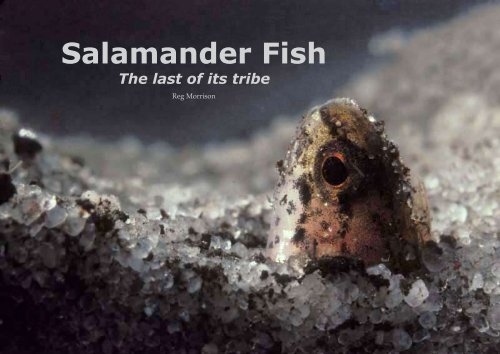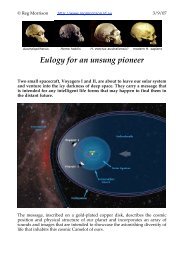Salamander Fish
Salamander Fish - Reg Morrison
Salamander Fish - Reg Morrison
- No tags were found...
You also want an ePaper? Increase the reach of your titles
YUMPU automatically turns print PDFs into web optimized ePapers that Google loves.
<strong>Salamander</strong> <strong>Fish</strong>The last of its tribeReg Morrison
The home of the<strong>Salamander</strong> <strong>Fish</strong>Lepidogalaxias salamandroidesDistributionNorthcliffeAlbany<strong>Salamander</strong> <strong>Fish</strong> live in the acidic, ephemeral creeks that originatein the forests of giant Karri and Jarrah trees in South-WesternAustralia.A <strong>Salamander</strong>-<strong>Fish</strong> habitat, near Northcliffe, WA.A Karri forest near Northcliffe, WA.
BURROWING FOR SURVIVAL1The first sign ofsun or wind onthe fish’s bodycauses it to beginburrowing.23The U-turnAestivationBy arching its back and thrashing its tail the <strong>Salamander</strong> <strong>Fish</strong> chiselsaside the leaf litter and surface sand with its wedge-shaped snout,and then tunnels vertically downwards, almost the full length of itsbody. Next, it executes a sharp U-turn, aided by its very flexibleneck, and works its way upward once again. When its head drawslevel with its tail all movement stops, leaving it in a U-shape with itshead and tail beside each other anywhere from 2cm. to 60cm. belowthe surface. The burrowing process is made much easier by a sleeveof mucous that exudes through its skin, and this briefly continues toaccumulate after the burrowing stops. As this mucous sleeve dries itforms a protective ‘sleeping bag’ that inhibits any further loss of thebody’s precious reserves of water. When this stage is complete thefish’s metabolism slows and aestivation begins.Aestivation is the summer-time equivalent of winter hibernation, inwhich the animal’s metabolism slows right down and an energy-savingtorpor envelops the body. When the fish’s immediate reserves ofenergy are almost exhausted it begins to draw upon a keel of fattytissue that has been built up along the underside of its body duringthe preceding winter. The return of water to its home pool triggers avery fast awakening. The fish digs its way out and resumes its normalgill-breathing, fully aquatic life within several minutes.Another remarkable feature is the <strong>Salamander</strong> <strong>Fish</strong>’s system of fertilisation.The anal fin of the male becomes modified into a vehiclefor sperm delivery known as a gonopodium. In conjunction with amodified anal scale, the <strong>Salamander</strong> fish regularly achieves the fishyequivalent of modern penis-based intromissive reproduction.
WHEN THE RAINS RETURNAwakened from aestivation by a fresh flow of water to itshome pool this <strong>Salamander</strong> <strong>Fish</strong> begins to wriggle freeand resume aquatic life. The survival of this ancient fish indrought-prone south-western Australia shows that it caneasily withstand many weeks of waterless air-breathing.
Having just emerged from air-breathing aestivation the blood-flushed gill regions of these fish remain suffused with capillary blood.
Origins and RelationshipsWhen the <strong>Salamander</strong> <strong>Fish</strong> was first scientifically describedin 1961 it was assigned to a relatively common southern hemispherefamily of freshwater fish, the galaxiids. However, accordingto some later researchers, Lepidogalaxias displayed certainphysiological characterisics that suggested a genetic connectionwith either the large, voracious pike family of the northernAmerica and Europe, or with their close relatives, the salmonfamily. In addition, they display several primitive characteristicsthat imply a very long and stable evolutionary history—a historythat goes back to the time of Pangaea, the supercontinent towhich almost all the world’s landmasses were once linked.If indeed these diminutive fish are members of the pikefamily (the esocoids), then a Pangaean origin and subsequentcontinental drift provide the only possible explanation for theirmodern distribution. The vast network of rivers, lakes and waterwaysthat characterised the supercontinent would have enabledtheir ancestral family to disperse widely throughout thesupercontinent. When it disintegrated the divergent drift of itscomponent continents would have carved the family into numerousisolated branches, most of which failed to survive. Manythousands of kilometres of inhospitable saltwater and innumerableland barriers now separate the little <strong>Salamander</strong> <strong>Fish</strong> fromits erstwhile relatives in the northern hemisphere.There is also a possibility that its closest relatives are thesoutherm hemisphere galaxids. This scenario too, depends tosome extent on the rafting of continents to explain their distributionamong the southern continents that once formed thesupercontinent of Gondwana.PANGAEA, the supercontinentA little more than 300 millionyears ago all the world’s majorlandmasses appear to have congregatedinto a single gigantic supercontinentthat stretched almostfrom pole to pole down one sideof the planet. This extraordinaryconjunction of landmasses lastedfor almost 100 million years andenabled all aquatic species to gaina broad distribution very swiftlyvia the vast interlinked system ofrivers and inland waterways.
Queensland Lungfish (Neoceratodus forsteri)Like the <strong>Salamander</strong> <strong>Fish</strong> the Queensland Lungfish can also breath air, but unlike the <strong>Salamander</strong><strong>Fish</strong> its single subsidiary lung doesn’t allow it to live long out of water. Neither doeslungfish fertilisation occur internally. The eggs are fertilised outside the mother’s body andbecome attached to water plants (LEFT). She doesn’t appear to nurture her young in anydirect sense but tends to linger in their vicinity (ABOVE). The Queensland Lungfish displaysthe most primitive characteristics of the the world’s three extant species.
The photographs, maps and diagrams in this work are subjectto the author’s copyright unless otherwise indicated.Reproduction rights and photographic prints may be obtainedvia email application to:regm@optusnet.com.auWebsite: www.regmorrison.id.au




